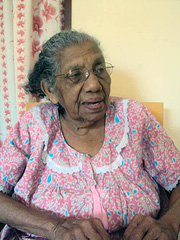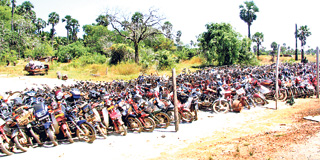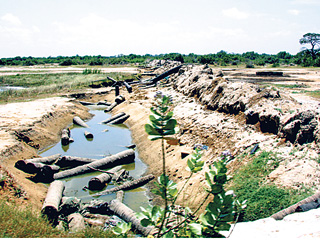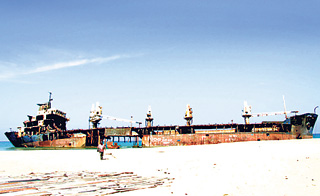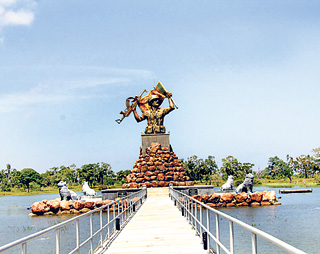CURRENT AFFAIRS INTERVIEW
The controversy surrounding the victory of Mahinda Rajapaksa in the Sri Lanka presidential election over combined opposition candidate Sarath Fonseka, refuses to die down. World attention is focussed on the detention of General Fonseka, the former Army Commander and once-wounded war hero who led the action against the LTTE. So far, except for general statements hinting at a coup attempt and a broad conspiracy, the Sri Lankan government has chosen to remain silent about the real reasons behind Fonseka’s confinement and impending trial.
In an exclusive interview, Defence Secretary Gotabhaya Rajapaksa — a former combat officer in the Sri Lankan Army, the real boss of the armed forces and also the President’s equally controversial brother — tried to make a case for the government. He spoke to senior journalist and author INDERJIT BADHWAR:Under what specific charges did your government arrest General Fonseka?I cannot talk about specific charges because the summary of evidence preceding the chargesheet is now being prepared by the military authorities under specific rules that guarantee due process and a fair trial. That is the work of the prosecutor.
Because there are no specifics so far, this looks like personal vendetta. Not at all. Most people are probably unaware of the damage done by the General to our military while he was in uniform, particularly in the way he entered politics.

PHOTO right:
Unholy mess Sri Lankan police manhandling a monk protesting the detention of General Fonseka
Should he have stayed out of politics? What is this damage you speak of? Of course he has that right in a democracy. But he misused his office to pervert the process. Most people tend to simplify this story into three parts — he fought a successful war; he was the army commander; he was arrested because he challenged the president in the election. The real issue is the damage he did by politicising the military. We share a proud tradition with India as the only countries in the region that can boast of a neutral military, but when that tradition was subverted in Sri Lanka by Fonseka, there was no option but to take action against him.
As a war hero, he has many admirers who urged him to contest…He should have made a clean break from the military and then entered politics. In his utter greed for power, he used his position and contacts for his own benefits. He did this while he was Chief of Defense Staff (CDS), and also when he was army commander. He used the commander’s bungalow for political activities and military resources for personal political use.
What kind of political activities? And why the haste in arresting him?While he was CDS, he was talking to commanders, senior officers. There were complaints of a few soldiers about asking them to work for him. If we did not act on this, we would be signalling that in future others can get away with this. The tradition of a neutral military so precious to us — and India — would have been destroyed.
 Can you be more specific about your phrase “using soldiers”?
Can you be more specific about your phrase “using soldiers”?Young, lower-level soldiers manning roadblocks were stopping vehicles and seeking votes for the general. Most of them were in a confused state when their own commander contests. In fact, he tried to gather support even among army deserters to whom he gave shelter.
PHOTO: Combative Sri Lanka Defence Secretary dismisses charges of war crimes against his armyHe was also using officers and soldiers to conduct surveys and compute vote percentages to measure his support within the army, and this started while he was still the commander. When we found out, we acted against 15 senior officers who were sent into compulsory retirement.
Aren’t there other very serious allegations that the general was planning a coup and assassination of the President and his family?Well, those are covered under civilian law and are the subject to procedures of criminal investigations, which are a separate procedure. The general’s arrest is in connection with offences he committed while he was in uniform.
Western media and human rights groups are highlighting his arrest and charges of a vendetta.I’d like to know why they didn’t highlight his public statements during the election when he was openly saying he would arrest the President if he is elected and put him and his ministers in cages.
There were corruption charges against him when he was the army commander — that he was influencing officers to purchase arms from his son-in-law Danuna Tilekeratne’s company Hicorp International. Why didn’t you arrest him then? Well, the details are only now coming out because there’s been a falling out among the suspects.
Supporters say he is being punished for favouring a quick political solution to the Tamil issue, on war crimes, and the speedy resettlement of the IDPs (internally displaced persons).I wish more journalists would do their homework. Why don’t you simply analyse his speeches while he was still in uniform, immediately after the war, and those he made when he became a candidate? His first speech to soldiers was that they had not lost their lives and shed their blood only to allow politicians to implement political solutions: ‘We will not allow this’. Is this not an attempt to mobilise the military against the political system?
What about his allegations that you ordered the troops to shoot down LTTE leaders who were surrendering with white flags, in cold blood?After the war, Fonseka gave a lecture in his old school where he said that the political leadership was trying to protect LTTE interests by asking them to surrender. Now, he reverses his stand, talks about a political solution and says I gave orders to shoot people waving white flags of surrender.
What really happened? On May 18, 2010 — the day Prabhakaran was killed, 200 LTTE leaders were trapped in an area 400 metres by 400 metres, surrounded by the military. It was past midnight, making it difficult to see them coming out with white flags from the dense jungle. Then some of them counterattacked. Prabhakaran was trying to escape to the lagoon, his son went in another direction. 10,000 surrendered cadres came down from one side. In in the thick of battle, can you expect a young recruit to recognise a senior LTTE leader and take a decision about whether to shoot him or spare him?
The war crimes issue is still alive in the West. What is your opinion? Yes we recognise what a war crime is — conducting revenge killings, abductions, ransom under the pretext of a military operation. And we have arrested, tried and punished soldiers for this. But there are situations over which we have no control. They claim, for example, that we bombed a hospital. If it is marked as a hospital and we deliberately bomb it, that’s wrong — but we didn’t. Then again, it was the last phase of war. The LTTE were trapped in a small area, where it was difficult to control a stray bullet hitting a hospital. Moreover, in a situation like this there’s no question of patients or civilians in the area.
Why would the western powers want to back a military man? First, there is a very powerful and moneyed diaspora within LTTE sympathies who play a crucial role in these countries, participates in their vote bank politics and media. Second, because Sri Lanka did not toe the line on certain strategic policies; and third, the human rights lobbies are pushing war crime trials to which they believed the UNP, supporting the general, would be more amenable.
Are the general’s criticisms of your government’s treatment and rehabilitation of IDPS, a source of concern?As general, he was the only person on our Security Council who opposed the early settlement of the IDPs — the only person. He kept arguing it was a huge security risk. That’s the only reason that the resettlement of IDPs was delayed. When as CDS he had opposed their release. Later on, made common cause with the opposition, which was using the IDP issue to blame the government during the election.
What finally happened?Newly liberated areas, like Jaffna, the peninsula, and the east were safe and IDPs could be sent back early. Fonseka had a firm “no”. So I said let them at least go to temporary camps in the eastern province. But Fonseca ordered them to be dragged back to the original detention areas. We were under pressure from the UN and other countries but the general kept arguing ‘security’. Finally, the President himself intervened. He said: “What security are you talking about? Here are 300,000 people in these camps; some 20,000 LTTE supporters and cadres have already escaped. So where’s the security? I want them resettled immediately!”
WRITER’S EMAIL
ibadhwar@gmail.com
Post LTTE factor; vigilance the keyIt was through Defence Secretary Colonel (Retd.) Gotabhaya Rajapaksa that we got to know that the Government of Eritrea, formerly a part of Ethiopia, a country in the Horn of Africa, had refused to accredit the Charge d' Affaires of the Government of Sri Lanka. The Foreign Ministry has so far made no comment.
It was the Foreign Minister who proposed in August last year that diplomatic relations be opened with the new state. He cited the usual education, trade, economic and political ties between the two countries, but also said that "the exchange of security and intelligence information" is vital to Sri Lanka.
The latter seems to have been the main factor because Eritrea had been considered a trans-shipment point for arms and hub for LTTE activities in the past, and the Government was rightly concerned that it needed a point-man there to monitor these moves.
Hence, though our ambassador in Cairo was to handle diplomatic relations in Eritrea, a senior army officer was to be posted to the station. There was some logic to this, given that it was a military officer in South East Asia who nabbed LTTE kingpin and arms procurement chief Kumaran Pathmanathan alias 'KP'; but whether the officer should have been sent before a diplomat to open the mission is a moot question.
The Defence Secretary blames the entire fiasco on newspaper reports that revealed Sri Lanka's overt intention of keeping a tabs on movements by whatever LTTE fringe elements remain in that part of the world.
One must ask if the normal diplomatic practices were followed. Usually, an agreement is reached between the two countries to establish diplomatic relations. We are told that this was done in Cairo on November 15 last year. The Foreign Minister's cabinet paper to open a diplomatic mission in Eritrea pre-dates this agreement. It is only after such an agreement that the two parties would move for concurrent accreditation. Delegations of senior officials visit each other and then agreement is reached on opening a mission and deciding whom to send. We seem to have put the cart before the horse, and the Foreign Ministry's 'press release diplomacy' about 'finding Eritrean links' etc., clearly unnerved this newly emerging nation.
The LTTE factor is a key issue for the Government, and it is only right that the Defence Ministry keeps a close tab on any developments, but it is important that the Foreign Ministry backs it up with the required expertise on diplomatic protocol.
The Eritrean fiasco must be read with the events that unfolded in London last week, where the Global Tamil Forum (GTF) was held with state patronage.
The Government of Sri Lanka viewed this as an unfriendly act by the British Government. The final declaration of the GTF calls for an economic boycott of Sri Lanka, investigations into 'war crimes' - and self-determination for the Tamils. It is to this type of conference that the British (Labour) Government lent its patronage.
While Sri Lanka's Foreign Minister summoned the British Acting High Commissioner in Colombo and conveyed his Government's dismay, in London our High Commissioner could only meet a Deputy Director of the South Asia desk at the Foreign Office.
It was a terrible comedown for the High Commissioner accredited to the Court of St. James', but then that is the depths to which our foreign relations have plunged. The High Commissioner should not have gone to Whitehall for that meeting. If the Permanent Secretary could not see him, he should have just posted his protest letter.
If that is the kind of hardball the British Government is playing, and we wish to reciprocate, our High Commissioner should have been recalled to Sri Lanka for 'consultations' -- a diplomatic message that conveys unhappiness with bi-lateral relations. We were quick to recall our Ambassador for not being present (he was on leave) when our Prime Minister went to Japan on a private visit, but not for this affront.
Unfortunately, this Government doesn't seem to heed the nuances of protocol, nor realize what a diplomatic snub is, as long as it can play to the gallery in Colombo with street demos demanding that the British go home.
Still worse was that at the meeting, the Deputy Director had pointed out passages of Foreign Secretary David Miliband's speech at the GTF meeting on non-violence, criticising the LTTE for terrorist activity, recruiting child soldiers and not tolerating dissent, -- as if our High Commissioner cannot read English.
Mr. Miliband had also lectured Sri Lanka on human rights. This from one known for duplicity even at home; he recently hired a star Queen's Counsel Jonathan Sumption to suppress evidence of the MI5's (the British External Secret Service) complicity in torturing a terrorist suspect in a case before the British High Court.
One can empathise with the British (Labour) Government battling to survive at the upcoming parliamentary elections and desperate for every British Tamil vote. This arguably, is not the time for it to be considerate towards a fellow Commonwealth member-state and think how it would feel if the Colombo Government supported an extremist Islamic organization that had sympathies with al-Qaeda.
But, enough of British hypocrisy. Where is Sri Lanka's foreign policy heading? Just the other week we lost the GSP+ duty concessions for Sri Lankan exports to Europe despite four Cabinet Ministers making frequent visits to Brussels promising the President that they can turn it around. And, Sri Lanka cannot hope for a change of heart in Britain later this year because even the opposition Conservative Party only recently reprimanded Sri Lanka on the manner it was handling its democracy.
The Defence Secretary has conceded that it is "very difficult" to suppress the residual elements of the LTTE internationally - the 'transnational, transitional Eelam' without the support of the West.
Isn't there then an urgent need to re-evaluate Sri Lanka's foreign policy with the West? The credo of the new world is engagement, not confrontation.




